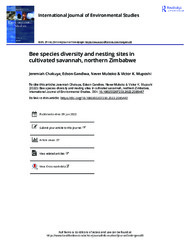| dc.contributor.author | Chakuya, Jeremiah | |
| dc.contributor.author | Gandiwa, Edson | |
| dc.contributor.author | Muboko, Never | |
| dc.contributor.author | Muposhi, Victor K. | |
| dc.date.accessioned | 2022-09-28T09:47:48Z | |
| dc.date.available | 2022-09-28T09:47:48Z | |
| dc.date.issued | 2022-06-09 | |
| dc.identifier.citation | Chakuya, J., Gandiwa, E., Muboko, N., & Muposhi, V. K. (2022). Bee species diversity and nesting sites in cultivated savannah, northern Zimbabwe. International Journal of Environmental Studies, 1-10. | en_US |
| dc.identifier.issn | 00207233 | |
| dc.identifier.uri | 10.1080/00207233.2022.2085447 | |
| dc.identifier.uri | https://hdl.handle.net/13049/538 | |
| dc.description.abstract | Bees play key roles in savannah ecosystems but face myriad threats. A combination of flower sweep netting and visual observations was used to determine bee-species diversity and preferred nesting sites in five villages in Nyamakate communal area, northern Zimbabwe. Almost 2000 bees were collected comprising two bee families and five species with diversity of Shannon-Weiner index (H’) = 0.45 (0.19). Apis mellifera scutellata was widely distributed and the dominant bee species; it has a wide choice of nesting sites and high adaptation ability. Effective conservation of nesting habitats such as forest, woody vegetation, and riverine water sources is required to maintain bee-species diversity in an agro-based savannah ecosystem. | en_US |
| dc.language.iso | en | en_US |
| dc.publisher | Taylor & Francis Online | en_US |
| dc.relation.ispartofseries | International Journal of Environmental Studies;1-10 | |
| dc.subject | Agro-ecosystem | en_US |
| dc.subject | Apis mellifera | en_US |
| dc.subject | Bees | en_US |
| dc.subject | Diversity | en_US |
| dc.subject | Savannah | en_US |
| dc.title | Bee species diversity and nesting sites in cultivated savannah, northern Zimbabwe. | en_US |
| dc.type | Article | en_US |

